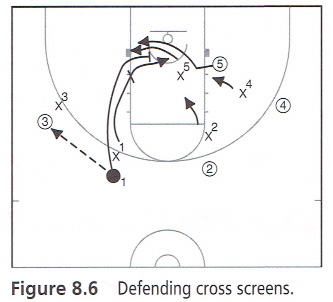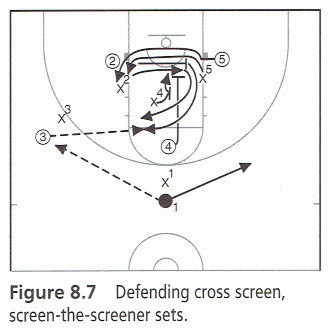| Defending Cross Screens |
| By: Lee Rose
Originally Published in: Winning Basketball Fundamentals - Provided by: Human Kinetics
There are two effective ways of getting into the cross screen. First, the low-post feed can come from a direct pass when the guard begins on the low block, crosses the free-throw lane, and sets the screen for the center. The second technique can come off an indirect pass as the guard initiates the play from the perimeter position and runs into the cross screen. Both are defended the same way. For illustration purposes, the cross screen that follows begins with the guard on the perimeter. Focus Execution, communication, and techniques versus the cross screen. Procedure Players begin on the half court five on five. Follow these steps: 1. Player O5 sets up on the right-side low block. O1 begins the play with a pass to O3 at the free-throw line extended. 2. O1 runs a hard cut to the same-side low block while working into position to set a cross screen for O5. X1 must be alert to bump O1 as he moves across the free-throw lane in preparation for a screen on O5's defender. 3. The physical action begins as O1 moves across the lane, looking to set a screen on X5. In preparation for the cross screen, X5 must be in position to see both the ball and the opponent. 4. Both X1 and X5 must execute their defensive techniques to avoid getting caught in the screen. X1 forces O1 down and low so that O1 cannot get a good angle to screen X5. X5 steps toward O1's screen while maintaining vision, position, and hand contact with O5. 5. X5 pushes O5 down toward the end line under the block, and X1 steps directly in the passing lane in front of O5 and prevents O3's pass. X5 maintains contact with O5 and works to maneuver O5 off the low Figure 8.6 Defending cross screens. block (Figure 8.6). 6. The reason that O1 screens for O5 is to produce a switch. In this case, X5 needs to step back and make sure that O5 does not get across the lane on the inside. X5 must push with his arms and force O5 toward the baseline. Then Xl, defending O1 setting the screen, bumps O5, slowing him down to give X5 time to regain position on O5. Focus Execution, communication, and techniques versus cross-screen, screen-the-screener sets. Procedure When offensive teams see the defense forcing down crossing action and how the defense plays the cross screen, they will change and involve a third screener in the play, causing more defensive adjustments. Players begin on the half court five on five. Follow these steps: 1. Play begins with O1 in the middle of the court above the top of the key, O2 on the left block, O5 on the right block, O4 in the middle of the free-throw lane, and O3 on the left side, free-throw line extended. 2. O1 passes to O3 and moves directly to the right-side free-throw line extended. On O3's catch, O2 executes a cross screen for O5, who relocates to the left block. Both X2 and X5 must execute their defensive techniques to avoid getting caught in the screen. X2 forces O2 down and low so that O2 cannot get a good angle to screen X5. X5 steps toward O2's screen while maintaining vision, position, and hand contact with O5. 3. O4, on the free-throw line, sets a pin-down screen on O2's defender as O5 is moving across the lane. O2 uses O4's screen to flash to the middle of the free-throw circle, looking for a catch-and-shoot. O4 posts up on the right-side block. Defensively, the big issue comes into play with O4's screen on X2. X4 must bump O4 and slow up the pin-down screen (Figure 8.7). It may also cause O2 to commit a three-second violation. 4. O3 has three basic options. The first look is to O5 posting up, the second choice is to O2 at the free-throw line, and the third alternative is to reverse the ball to O1 by passing or dribbling. Defending this set is difficult if the offensive team sets good screens. What is required is a coordinated defensive effort with a lot of talking, bumping, denying, and possibly switching on the last screen to prevent an easy basket. Defending Pick-and-Roll Screens The pick-and-roll screen on the ball is one of the most frequently used and effective offensive sets in basketball, often separating the good players from the great ones. The pick-and-roll is a direct attack on guards who cannot get over screens, post players who will not step out with the screener, and weak-side defenders who go to sleep on good jump shooters. Because offensive schemes offer many ways of getting into the pick-and-roll, coaches must have a well-developed defensive plan of attack Early on, the pick-and-roll was used between the guard with the ball and a big man setting the screen either on the sideline or, more often, at the top of the key. Today, the pick-and-roll has become an offense unto itself. The pick-and-roll is especially hard to defend when it is initiated by a skilled offensive guard who makes good decisions. Not all guards can run the pick-and-roll effectively, but the great ones make their living doing it; Steve Nash of the Phoenix Suns, Chris Paul of the Los Angeles Clippers, and John Wall of the Washington Wizards control their teams' offense by running the pick-and-roll almost exclusively. Good point guards have flexibility in knowing when and where to attack their opponent. Choosing the time and floor location to run the pick-and-roll depends on the team's individual personnel: Some teams focus on the sideline, some like the middle, and others are exceptional in transition using drags (like the 2012 Miami Heat, with Dwyane Wade and LeBron James handling the ball). This requires the defense to define exactly how they are going to defend each procedure. Pick-and-roll screens on the sideline and in the middle are predetermined and less complicated to cover because the defense knows that they are coming. Currently, the problems that defenses must deal with are random pick-and-rolls and multiple cross screeners. More teams are using the run-in-to across the free-throw lane pick-and-roll technique. Many techniques are used to defend the pick-and-roll: the trap, the hedge and get back (the defender guarding the player who is setting the screen takes a quick step out and shows himself as if preparing to trap the dribbler but is only buying time, or slowing down the ball handler, so that the teammate who is guarding the dribbler can catch up), the hard hedge (the big man steps out and does not let the dribbler split him and the other defender or turn the corner), the show or get through (the defender shows but backs off to help his teammate maintain a good defensive position on the ball handler), the soft play (the defender stays back and does not commit to attacking or faking at the ball handler), and the switch. The defensive method employed depends on talent, team speed and quickness, the ability to anticipate, and the opponent's effectiveness in running pick-and-rolls. Regardless of where on the floor the offense runs the pick-and-roll or the defensive method used to defend it, the defender should follow three important rules: 1. The defender on the screen setter must communicate by talking and letting his teammate know that the pick is coming. 2. The defender on the ball must not let the offensive guard split him and the defender on the screener. 3. If the decision is to trap, the defenders trapping must stay in it until the guard passes the ball. |








